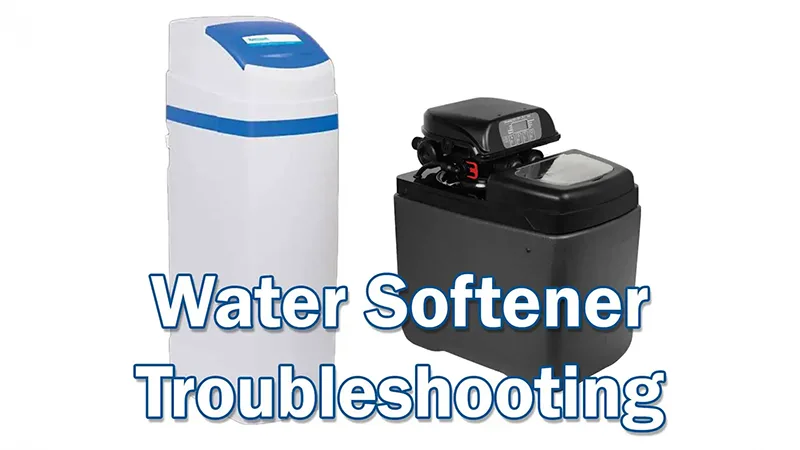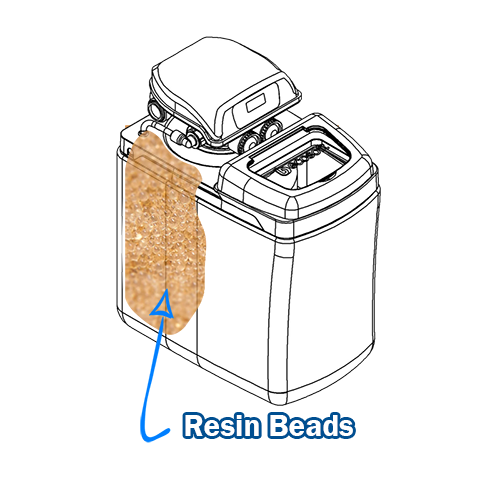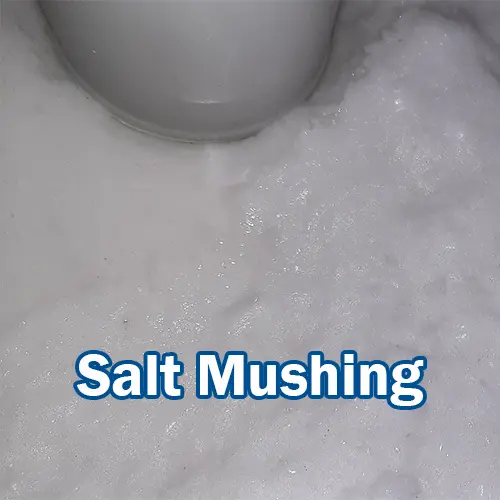water softener troubleshooting
- Guides
- by Louise
- 29-07-2024

Troubleshooting Common Water Softener Problems
You’ve installed a quality water softener and everything is ticking along nicely until disaster strikes and the water softener you’ve been relying on to give you softened water no longer does.
You’ve hit a snag and haven’t a clue how to fix it.
We’ve put together this water softener troubleshooting guide to highlight common water softener problems.
With help from Fountain Filters, you can overcome any water softener problem.
Water softener problems should be fixed quickly to avoid a break in your softened water supply and further damage to your water softener system and household appliances.
After you’ve read Fountain Filter’s water softener troubleshooting guide, they’ll be certain problems that you’ll confidently fix yourself and others where you may need to call in a water softener professional.
Common water softener problems
 Just like any other household appliance, water softener systems are prone to the odd problem or two. It’s important to keep an eye on your water softener and carry out regular maintenance checks so that you can resolve issues before they become a major problem.
Just like any other household appliance, water softener systems are prone to the odd problem or two. It’s important to keep an eye on your water softener and carry out regular maintenance checks so that you can resolve issues before they become a major problem.
Fountain Filters have an in depth article that focuses on how water softeners work, but essentially, water softeners have a mineral tank that filled with resin beads that are high in sodium ions. These resin beads attract and hold onto the hard ions – in this case calcium and magnesium, the minerals responsible for water hardness. The beads release the sodium ions into the water instead of the hard ions and soft water continues its journey into your household pipes ready to be used.
Over time the resin beads become saturated with hard ions and must be regenerated with salt or potassium chloride so that they continue to work effectively.
Regeneration of the resin beads involves flushing out the mineral tank with a saltwater solution. This strips the beads of the limescale deposits. The limescale is discharged and the resin beads are as good as new, ready to start working at maximum efficiency again.
It all sounds so simple and straightforward, but sometimes things can go wrong.
Here are some common water softener problems that you may come across, as well as water softener troubleshooting tips that will have your system back to full functionality.
1. Blockages or Clogging in your water softener
The same limescale that you’re removing from your household water can leave it’s scaly deposits on your water softening system. The water line that runs through the tank of your water softener can get blocked up with a mix of calcium and magnesium (the hard ions) and salt from the water softeners brine solution.
How to spot if your water softener may be blocked
 You can tell if your water softener may be blocked or clogged up because you’ll start to notice limescale deposits on your household appliances, in your kettle, on your glassware, down your shower screens.
You can tell if your water softener may be blocked or clogged up because you’ll start to notice limescale deposits on your household appliances, in your kettle, on your glassware, down your shower screens.
These red flags are warning you that your water softener isn’t working as effectively as it needs to and that it might be clogged up with limescale.
The Fountain Filters fix
Our water softener system troubleshooting fix is to locate the two areas in your water softening system where blockages are most likely to occur.
These areas are the valve injector and the brine line.
Firstly, let’s look at the valve injector. Check to see if the water in the brine tank is high. If it is, this is typical of a clogged valve injector. A clogged injector can reduce the water softeners ability to create suction for the brine cycle, which means the water softener can’t regenerate properly.
Shut the water off and then use a pair of pliers to pull the injector out. Look through the small opening for anything that might be stuck in there, using a fine needle or safety pin to remove the blockage if there is one. Replace the injector and turn the water back on.
Secondly, the brine line. Look at the brine line closely for signs of any deposits that could be restricting the flow of water. Before you go messing on with the brine line, you may need to ask a professional to clean the line for you to avoid damaging the water softener. Take note of how the professional does it and with what tools and maybe try it yourself next time. Make sure you look at your warranty before trying this at home though!
 2. Salt bridges or salt mushing in your water softener
2. Salt bridges or salt mushing in your water softener
A hard crusty salt bridge in the brine tank of your water softener blocks the salt from dissolving into the water to make brine.
If there is high humidity or unusual weather changes, this can cause the salt to clump together. Or, you may have been tempted to buy low quality salt, the sort of which is not recommended for your water softener.
Salt mushing is the sludgy equivalent to a salt bridge. It’s when the salt recrystallises on the bottom of the brine tank, and just sits there as a gooey mess.
The Fountain Filters fix
For a salt bridge, grab a brush handle and beat the salt bridge up until it resembles a bridge no more!
It’s a little more time consuming for the salt mush. You’ll need to drain and clean the tank before refilling it with good quality water softener salt.
3. Resin replacement in your water softener
The resin in your water softener is where the magic happens, where hard water turns into soft water through the process of ion exchange.
Over time, the resin gets a bit old, just like us! When this happens the water softener becomes less capable and will need to regenerate more often to keep up with supply of soft water into your home.
Look for sandy particles in the resin tank. If you see any it’s time to change the resin in your water softener – and quickly. You don’t want to risk damaging your water softener system. Chlorine can shorten the lifespan of the resin, so it might be an idea to remove chlorine from your water first before it even goes through the water softener.
The Fountain Filters fix
Before you call in the professionals to replace the resin and get your water softener back up to running at peak performance, you could try the short-term fix and adjust the water softener settings so that the system regenerates more often until you can get the resin replaced.
4. Motor issues
It’s fair to say that if something has moving parts, it can break down. Simon and I are marathon runners, and our moving parts break down all the time!
The motor on your water softener can also break down and this is not good as your system won’t be able to move between the different cycles, such as softening and regeneration.
If you’re sure it’s the motor in your water softener that’s failed, then here’s how to fix it.
The Fountain Filters fix
Before you reach for the phone in a panic, dig out your water softener user manual and check the cables and settings on your water softener just to make sure it’s not something else that’s preventing your water softener from working correctly.
If everything is OK following your initial check of the water softener and you are convinced it’s a motor failure, then dig out your warranty information and call the company you purchased your water softener system from as you may be able to get a new motor free of charge.
A water softening professional will then be on their way to you.
5. Brine tank overflow in your water softener
The brine tank of a water softener holds the salt. That salt water (brine) is used to clean (regenerate) the resin beads in the media tank. And those resin beads do all the hard work of removing the hard ions. If you don’t have a brine tank that’s working correctly your water softener won’t be working effectively to soften your water.
There could be several reasons why the brine tank may overflow, including a broken valve, clogged injector, blockage in the brine line, or a stuck float.
The Fountain Filters fix
Put your water softener problems troubleshooting hat on and check the following:
- Check the brine line to make sure it’s attached to the float inside the brine well, if it’s not then be sure to attach it.
- Ensure that there is a tight fit on both the brine tank caps and brine well.
- Remove any salt build up in the brine line float.
- The brine line valve can get clogged up with debris from the water so look for any salt clogging inside the brine tank.
- Make sure the drain line is free of any clogging or kinks.
- The valve injector could be clogged up, but you’d need a professional water softener engineer to check this for you and clean it out or replace it.
Troubleshooting your water softener
If you’re going to have a water softener installed, then we think that you also need to learn how a water softener works and how to water softener troubleshoot. This means becoming familiar with the user manual that would have been left with you when you had your water softener fitted. The manual will have a section dedicated to water softener troubleshooting and could save you money because many of the fixes you can do yourself.
Fountain filters wrote an article called ‘How to install a water softener’ that you might find useful in terms of understanding the steps a professional will go through when they are installing a water softener in your home.
Maintenance to prevent common problems with your water softener
Don’t wait for water softener problems to arise. Ensuring that your water softener is fully functional all day every day means that you should think about having is regularly serviced by someone who specialises in water softening systems.
In-between those services you can stay on top of any issues that arise because you’ll be familiar with the system and will have looked at water softener system troubleshooting sections in the user manual.
When to call a professional about your water softener
Sometimes there comes a time when you must call on the water softening experts. You’ve tried to fix things yourself and haven’t quite managed. That’s OK, it’s just because you don’t know the ins and outs of the water softener the way the experts do. They live and breathe water softeners and asking for help is always a good thing.
How Fountain Filters can help you with water softener troubleshooting
We’re always on hand, either by calling us on 01352 838 281 or sending us a helpdesk message when things go wrong with your water softener.
Many of the problems that you may come across with your water softener can be fixed by you, without the need to call a professional.
And before we forget, one of the questions we get asked a lot is ‘can you drink softened water’. We know it’s going slightly off the troubleshooting topic, but it’s worth a read.


